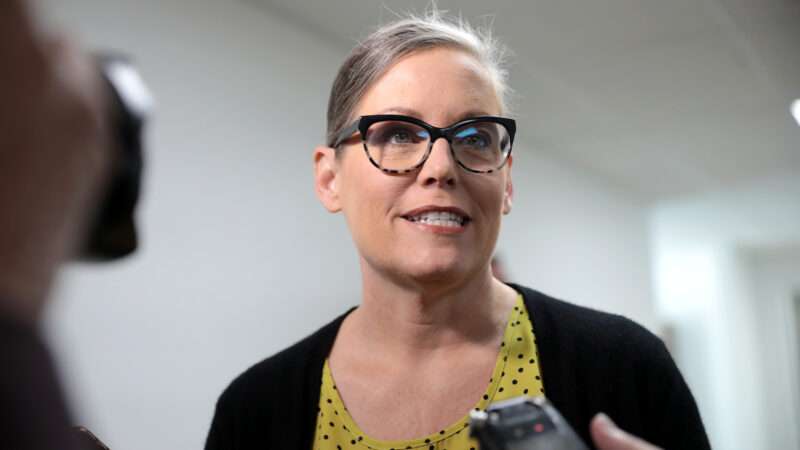
Before the start of the state legislative session in January, Arizona Gov. Katie Hobbs, a Democrat, proposed a plan to heavily regulate the state's universal education savings account (ESA) program. Her proposal aims to make private schools comply with some of the same standards adhered to by public schools, including requiring that private school teachers meet "minimum education requirements" before teaching ESA students and that private schools provide special education students the same services they had received in public schools. Additionally, she wants to require that students attend public schools for 100 days before receiving an ESA and for the state to audit expenditures at choice-participating private schools.
Hobbs's plan is an attempt to stifle Arizona's booming ESA program and bureaucratize private schools into operating much like the public schools that ESA students already opted out of. It also comes on the heels of a failed attempt to repeal the state's ESA program last year. Like last year, the state's Republican-controlled legislature is unlikely to go along with her measures and already killed one of the bills sponsored by Hobbs allies before it made it to committee in February.
Hobbs will find it difficult to rein in school choice in Arizona—not just because so many families are benefiting from it, but students also made impressive academic improvements while choice expanded over the past two decades.
National and state level trends in student achievement, public school staffing, and education funding for all 50 states are detailed in Public Education at a Crossroads, a new study by the Reason Foundation (the nonprofit that publishes this magazine). Because of lags in when the federal data are published, the paper only covers trends prior to the beginning of the COVID-19 pandemic.
In 2003–2019, Arizona students made substantial gains across the board on student achievement as measured by the National Assessment of Educational Progress (NAEP), better known as the Nation's Report Card. Across fourth- and eighth-grade NAEP scores for reading and math, Arizona ranks in the top ten in achievement growth when compared to other states, except for fourth-grade math scores for low-income students, where it ranks 14th. Fourth-grade scores for reading and math grew by 7 and 9 points, respectively. Eighth-grade scores on reading and math improved by 4 and 9 points.
The NAEP improvements are even more pronounced for low-income students. For Arizona students eligible for free and reduced-price lunches, fourth-grade reading and math scores grew by 8 and 9 points, respectively, and eighth-grade reading and math scores grew by 7 and 12 points.
Arizona also managed to improve student achievement while eschewing the conventional demands for more money and smaller class sizes in public schools. In 2002–2020, per-student revenues for public education only grew in inflation-adjusted terms from $10,353 to $10,790, a 4.2 percent increase that ranks the state 47th nationally in per-student revenue growth. Nor has the state prioritized reducing class sizes or adding support staff: Despite enrollment growth of 25 percent in 2002–2020, Arizona's public school staff only grew by 13.7 percent over the same timeframe. By comparison, public schools nationwide added staff at more than twice the rate of student enrollment growth.
Instead, Arizona spent the past few decades extending a breadth of education options to families. It was an early adopter of charter schools and public school open enrollment in 1994. The state also established the nation's first tax credit scholarship program in 1997 and the nation's first ESA program in 2011. Beginning in 2022, Arizona's ESA program, which was initially only available for students with disabilities, expanded to universal student eligibility and now serves over 75,000 students. Charter schools currently serve more than 20 percent of the state's public school population, a larger proportion than any other state.
Over this period, educational approaches that would be considered experimental in other states have matured and found comfortable niches in Arizona. Arizona Autism Charter Schools, currently with four campuses, specialize in serving kids with autism spectrum disorder and have been operating since 2013. Many of the state's other well-established charters have diverse instructional approaches including Montessori, STEM-focused, and classical education. There's even an environmental sustainability focused charter school for Navajo children in rural Arizona. Prenda, the popular microschool management platform, supports 149 private and charter-partnered microschools in Arizona. In Phoenix, the Black Mothers Forum adapted Prenda's model to better fit the needs of black families early in the pandemic.
To be sure, Arizona students don't fare as well in absolute NAEP rankings. For instance, the state's fourth-graders rank 44th and 36th nationally in overall reading and math scores. But it's hard to know the extent to which greater investments in public education would have led to better outcome growth in Arizona. Consider New York, which led the nation in per-student revenue growth in 2002–2020—increasing from $18,054 to $30,723, or 70.2 percent. Despite those massive funding increases, New York students made almost no NAEP gains over that period. In fact, Arizona's low-income students outscore New York's low-income students in fourth- and eighth-grade math.
The fact that students have gained academic ground in Arizona's choice-rich, fiscally conservative context cuts against Hobbs's attempt to hamper the state's ESA program. Parents in the Grand Canyon state have already proven themselves capable of holding schools accountable without her help.
The post Arizona Gov. Katie Hobbs Wants To Hobble School Choice, Despite Years of Student Achievement Gains appeared first on Reason.com.







